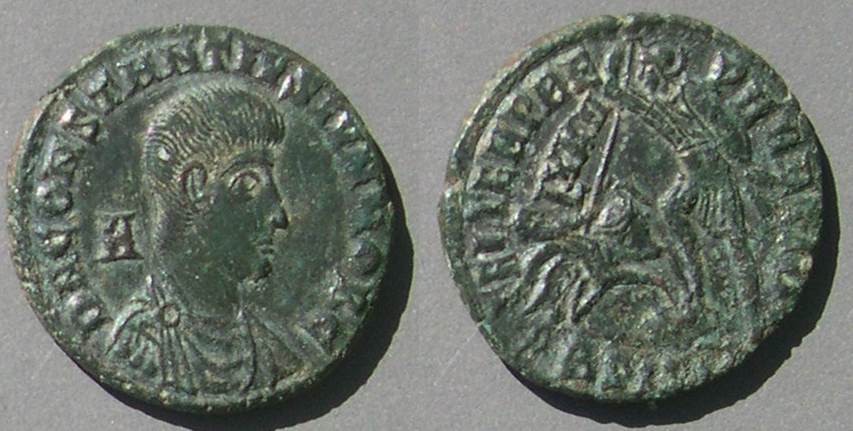 Coins of Constantius Gallus,
Coins of Constantius Gallus, Caesar, 15 March 351- Winter 354,
under the Roman emperor Constantius II
 Coins of Constantius Gallus,
Coins of Constantius Gallus,
Caesar, 15 March 351- Winter 354,
under the Roman emperor Constantius II
Constantius Gallus has ten copper reverse types, all of them shared with Constantius II. Four are FEL TEMP REPARATIO types of the coin reform of 348, three are types initiated by Vetranio and continued after Vetranio's retirement, one is a type of Magnentius which was adopted after Magnentius was overthrown, and two are other types just for Constantius II and Gallus.
This coin: 21 mm. Constantius Gallus/FEL TEMP REPARATIO, soldier-spearing-fallen-horseman. [This coin is discussed below.]
(Skip down to tables with all the types of Constantius Gallus.)
What's new? 2024, May 26: A very small Gallus soldier-spearing-fallen-horseman.
2022, Sept. 19: A second example of the galley type.
History. From 340 to 350 Constantius II was ruling in the East and his brother Constans was ruling in the West. When Magnentius overthrew and killed Constans in 350, Constantius II was in the far east. Magnentius advanced to Rome and Aquileia and prepared to move further east. Vetranio was magister peditum in the Balkans and realized there needed to be an emperor on the scene to deal with Magnentius, so he declared he was supporting Constantius II and awarded himself the title Augustus March 25, 350. When Constantius II was able to return from the East later that year, Vetranio abdicated Dec. 25, 350, and retired with honor. Constantius II needed someone to guard the East while he moved west to confront Magnentius. Gallus was chosen in March 351 as the oldest eligible relative. He was a half-nephew of Constantius II, a grandson of Theodora, and half-brother of the younger Julian II (who was not yet in the picture). Unfortunately, Gallus was a poor and harsh ruler who alienated everyone and even executed representatives of Constantius. When Constantius was informed of his behavior, he knew that attempting to remove Gallus might provoke a revolt, so he informed Gallus he should come west to be promoted and on the trip Gallus was executed.
Gallus or Constantius II? Coins of both Gallus and Constantius II have legend including CONSTANTIVS. Some coins attributed by sellers to Gallus are actually of Constantius II. All ten types distinguish Constantius II and Gallus in two ways. The first is that Constantius II minted these types as Augustus with legend ending PF AVG and Gallus minted as Caesar with legend terminating NOB CAES or NOB C (Gallus was never Augustus). The other is that Gallus was always depicted bare-headed while Constantius II has a diadem.

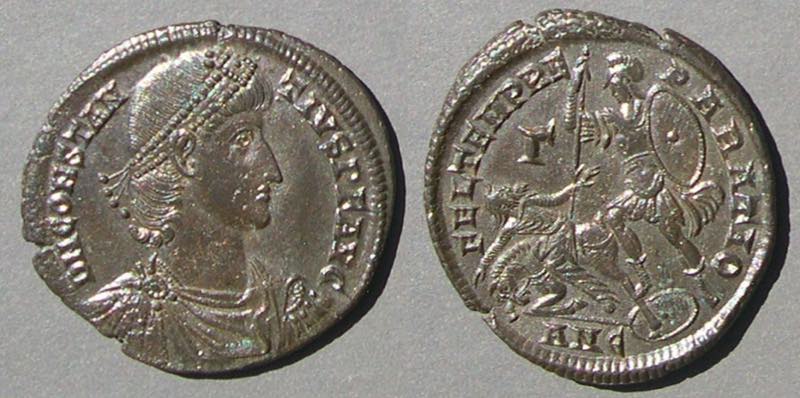
Left coin: 24-23 mm. Constantius Gallus, bare-headed with legend DN CONSTANTIVS NOB CAES
Right coin: 25-23 mm. Constantius II, diademed with legend DN CONSTANTIVS PF AVG
Note for Collectors: The large AE2 with "soldier spearing fallen horseman" is by far the most common type for Gallus (frequencies are discussed below). It was issued at several mints and comes in sizes from 23-24 mm declining down to 17 mm. (The type comes even smaller for Constantius II and Julian II, but not for Gallus.) Naturally, the larger ones are more desirable. It is hard to find in excellent condition, but when it is, it is likely to be the larger size. Almost all the smaller ones are poorly produced and poorly preserved.
Coins of Gallus are not distinguished with "GALLVS" or even a "G" in his legends. A relative of Constantius, he was originally named Gallus but his name was changed to Constantius when he became Caesar. His coins come with three legends.
Three legends. Some coins of Gallus have legend DN CONSTANTIVS IVN NOB C, where "IVN" is for "Junior," as on the next coin (and the first coin on this page).
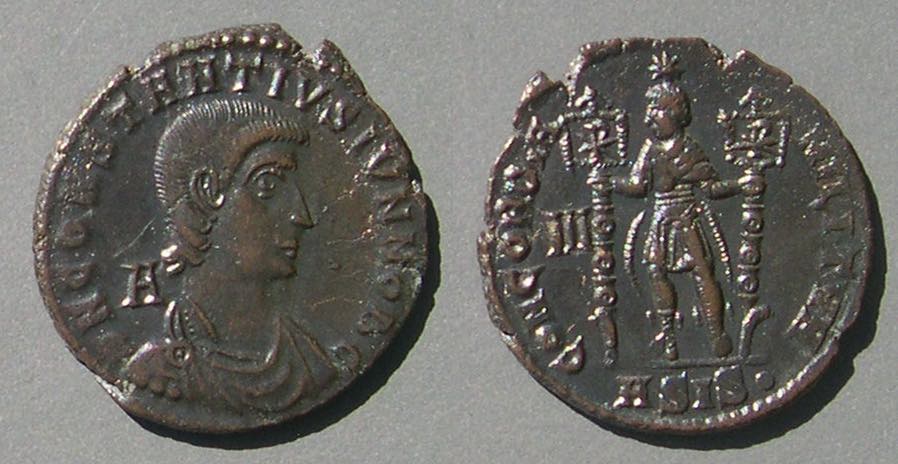 Constantius Gallus
Constantius Gallus
22 mm. 4.17 grams.
DN CONSTANTIVS IVN NOB C
Bare-headed
CONCORDIA MILITVM
Emperor holding two standards with chi-rhos, head left
III
ASIS•
RIC Siscia 308
Some coins have "DN FL CL ..." for Flavius Claudius, adding family names. Constantine II was Flavius Claudius Constantinus and Julian II was Flavius Claudius Julianus. Gallus was Flavius Claudius Constantius after his name was changed from Gallus.
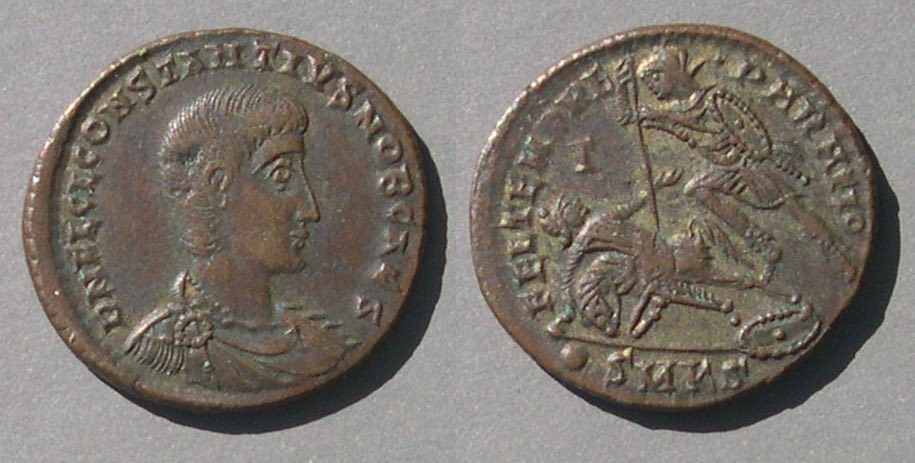
Constantius Gallus
22-21 mm. 4.93 grams.
DN FL CL CONSTANTIVS NOB CAES
FEL TEMP REPARATIO, soldier spearing fallen horseman
Γ
•SMKS
RIC Cyzicus 97 "C2"
A few coins have obverse legend FL IVL CONSTANTIVS NOB C, with the family name Julius in error. They are only from the first issue at Thessalonica before it was corrected in the second issue. Constantius II was Flavius Julius Constantius and Constans was Flavius Julius Constans, but Gallus was Flavius Claudius as on the coins above.
 Constantius Gallus
Constantius Gallus
22 mm. 4.16 grams.
FL IVL CONSTANTIVS NOB C
Bare-headed
CONCORDIA MILITVM
Emperor holding two standards with chi-rhos, head left
Γ
✳TSЄ✳
RIC Thessalonica 167 "S"
Table 1: FEL TEMP REPARATIO Types. The "FEL TEMP REPARATIO" coin reform of 348 introduced types used later by Gallus. He became Caesar in March 351. Magnentius (350-353) was already on control of the West all the way to Rome and Aquileia. In September 351 Siscia was also lost and the Sirmium mint was opened to replace it. Siscia was recovered in only a month, but the Sirmium mint continued anyway. Rome and Aquileia did not mint for Gallus until they were recovered for Constantius II in September 352. Trier, Arles, and Lyons did not mint for Gallus until August, 353, when Magnentius was defeated and the West recovered. Because the coin-diameters declined over time, most of the soldier-spearing-fallen-horseman coins of Gallus from the West are later and therefore smaller than the 23 mm coins of same type from the East.
| Size | FEL TEMP REPARATIO | Legend | References F = Failmezger |
Image (Sizes are proportional) |
| AE2 |
"soldier spearing fallen horseman" | FTR | F461-3 (three different sizes, larger to smaller) RIC: many mints and issues First coin: 24-23 mm. 6.14 grams. RIC Alexandria 74 "C2" Second coin: 16 mm. 3.15 grams. RIC Nicomedia 97 This type can be as large as 24-23 mm (earlier issues) or as small as 16 mm (latest issue). |
 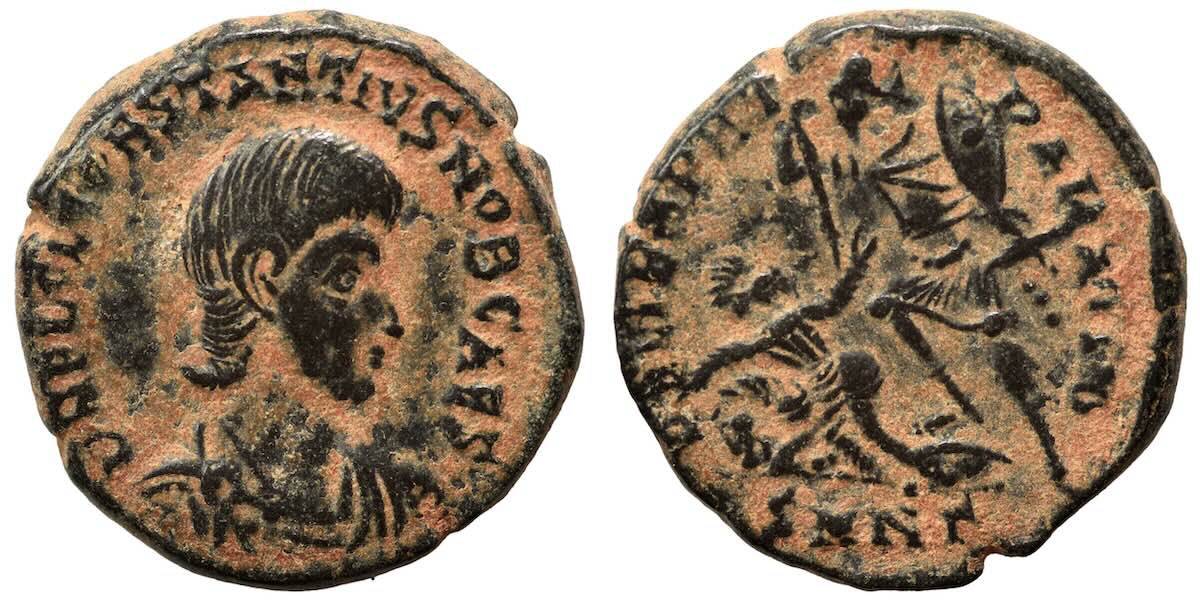 |
| AE2 | "galley" Emperor standing left on galley steered by Victory, being crowned by Victory on globe and holding labarum. |
FTR | F426 RIC Rome 250 "R3" RIC Siscia 329-331 "C" Thessalonica 169 "S", 179 "S" This coin: 25-23 mm. 5.53 grams. RIC Siscia 329. For Gallus this type is only in the early, large diameter, issue. |
 |
| AE2 | "emperor and one captive" | FTR |
|
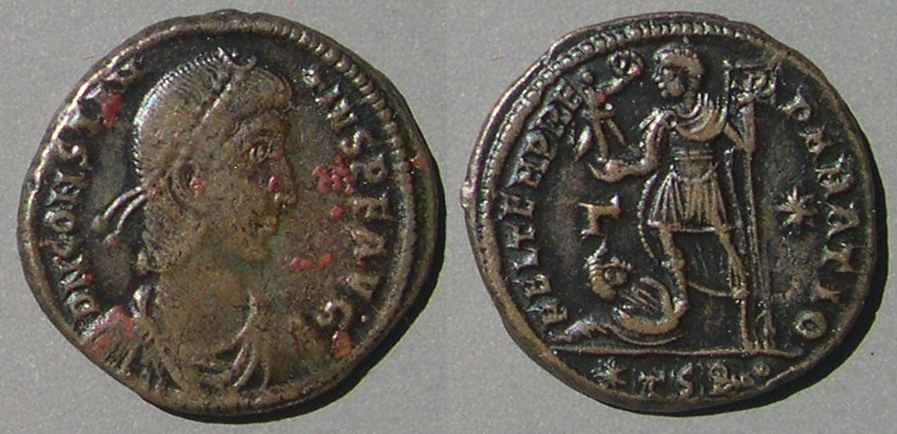 |
| AE3 |
"phoenix" |
FTR | F451 RIC Sirmium 27 "R" This coin: 18-17 mm. 2.84 grams. Not Gallus, but Constantius II of the same reverse type and issue. RIC Siscia 240 "C4" |
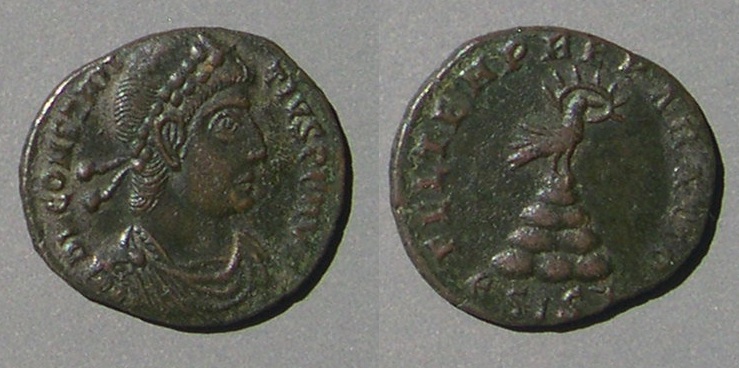 |
Table 2: Types of Vetranio. When Vetranio retired Gallus was not yet Caesar, but three of the six AE types new to Vetranio were continued under Constantius II long enough for Gallus to participate in their issue.
| Size |
Vetranio |
Legend | References F = Failmezger |
Image (Sizes are proportional) |
| AE2 |
emperor |
CONCORDIA |
F415 RIC Siscia 303, "S", 308 "R" Sirmium 22 "C" Thessalonica 167 "S" This coin: 24-23 mm. 5.25 grams. RIC Sirmium 24 |
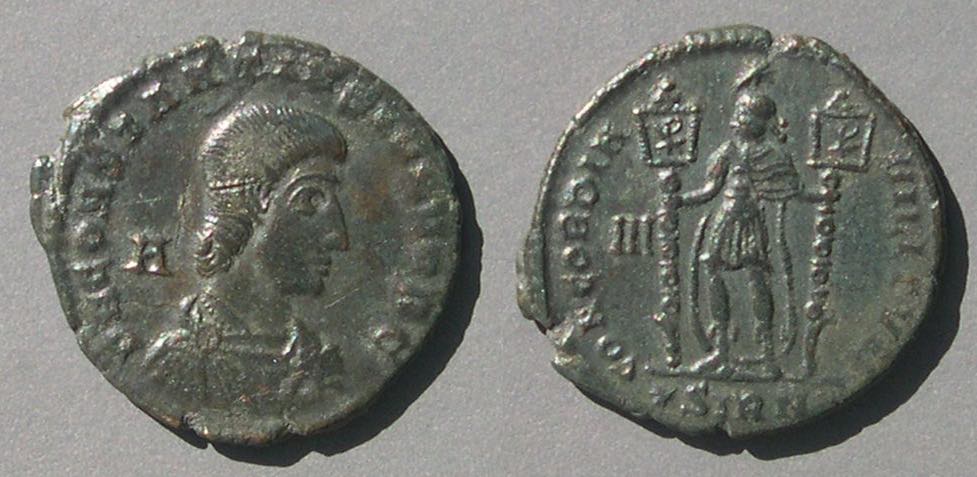 |
| AE2 |
emperor |
HOC SIGNO VICTOR ERIS |
F416 RIC Sirmium 24 "C", 31 "S" and RIC Siscia 306 "S", 312 "R" This coin: 23 mm. 6.75 grams RIC Siscia 306 |
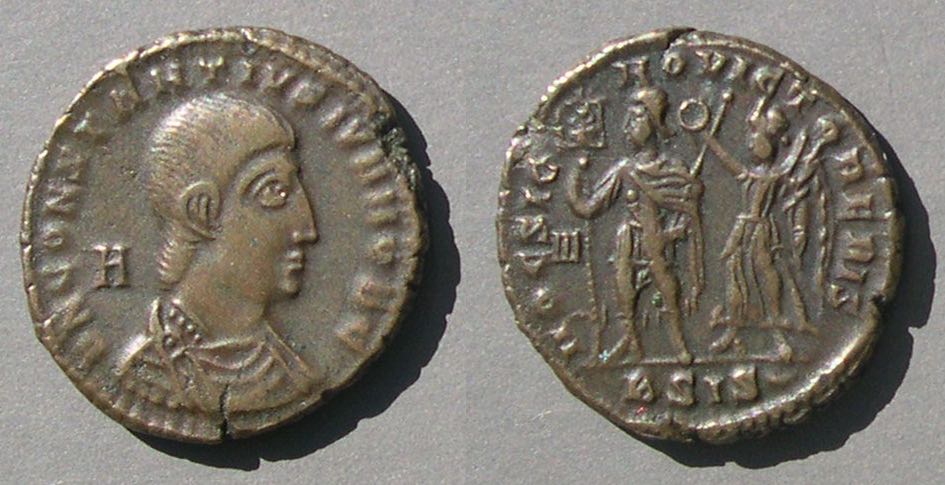 |
| AE3 | emperor standing holding standard in right and scepter in left |
GLORIA ROMANORVM | (Siscia only) F418 RIC Siscia 356 "S" [I'd say rare or very rare.] This coin: 21-18 mm. 2.46 grams. RIC Siscia 356 |
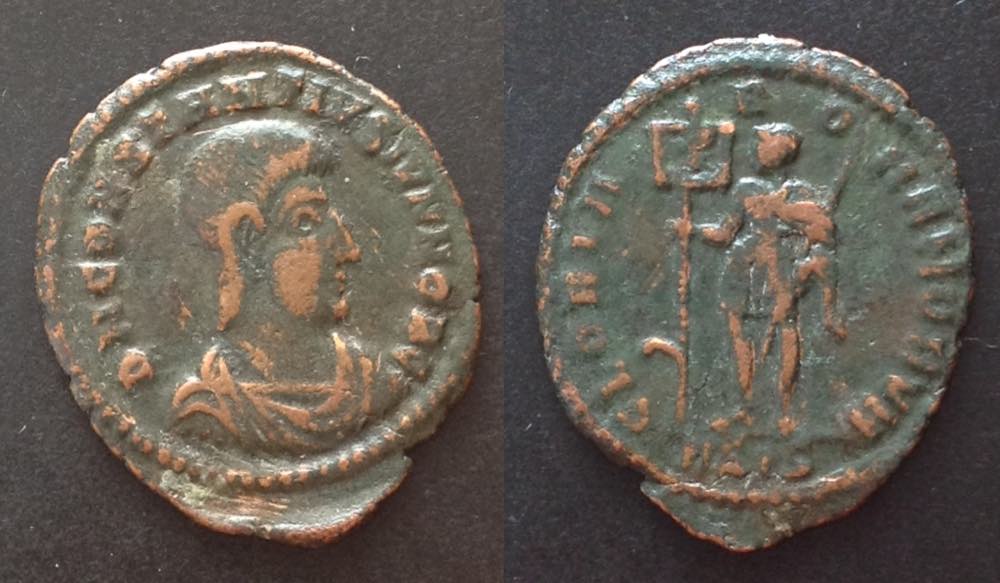 |
Table 3: Other Types of Gallus. The three remaining types are rare or very rare. One very rare type of Gallus is the "two Victories" VOT V MVLT X type that is very common for Magnentius and Decentius. Gallus used it unchanged. The vota numbers fit Gallus. Constantius II had it with his own vota number: VOT XXX. Two other rare types feature Victory advancing left with legends VICTORIA CAESARIS and VICTORIA AVGVSTORVM.
| Size | Type | Legend | References | Image (Sizes are proportional) |
| AE2 | Two victories, holding wreath, inscribed VOT V MVLT X | VICT DD NN AVG ET CAES | (Rome only) F443 RIC Rome 253 "R2" This coin: Not Gallus, but the corresponding type with "VOT XXX" for Constantius II from the same issue. 21-20 mm. 4.70 grams. F442, RIC Rome 252 |
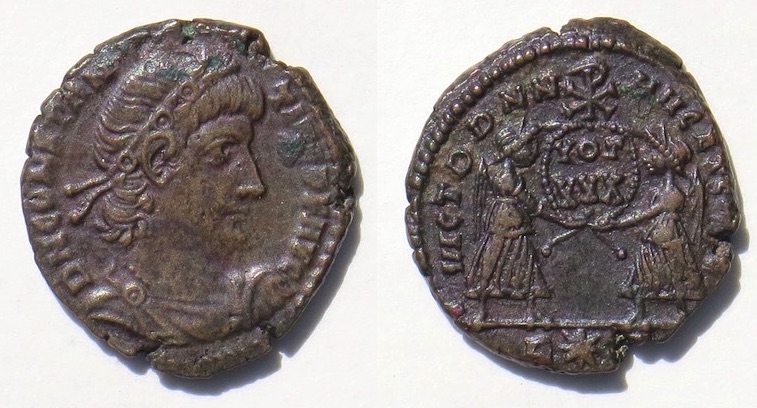 |
| AE3 |
Victory advancing |
VICTORIA CAESARIS | (listed for Siscia only) F456 "RR" RIC Siscia 317 "R" "15 March - August 351" Not in RIC for Sirmium, but see an example below. This coin: 19-18 mm. 2.87 grams RIC Siscia 317 "R" |
 |
| AE3 | Victory advancing left, holding two wreaths | VICTORIA AVGVSTORVM | (Siscia only) F455 "RR" RIC Siscia 314 "R" "15 March - August 351" This coin: Not Gallus, but Constantius II of the same reverse type. 21-18 mm. 2.03 grams. RIC Sirmium 25 "R" [See note, next] |
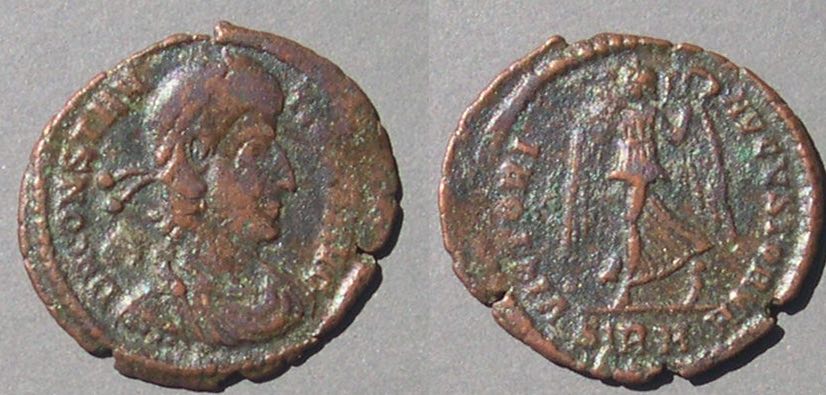 |
Note: The previous two types are from the same issue for Gallus and Constantius II. Obviously, CAESARIS is more appropriate for Gallus and AVGVSTORVM for Constantius II. Any coins of Gallus with AVGVSTORVM may simply be mint mistakes at Sicsia. The parallel issue at Sirmium has, in RIC, only AVGVSTORVM for Constantius II and nothing for Gallus, but the discovery coin below has CAESARIS for Gallus at Sirmium. At Sirmium each has only the appropriate reverse. So, it seems likely each was intended to have his own appropriate reverse at Siscia too and any Gallus pieces with AVGVSTORVM may be mules--coins with the wrong reverse by accident.
The end of the tables of types. You may quit here.
Go to the Table of Contents for these educational pages.
This page continues with more examples and commentary about those types.
Soldier-Spearing Fallen Horseman. The soldier-spearing-fallen-horseman type was 23 or 24 mm when initiated in 348 and soon became smaller.
 Constantius Gallus, 351-354.
Constantius Gallus, 351-354.
21-20 mm. 4.17 grams,
DN FL CL CONSTANTIVS NOB CAES
B behind bust (second series)
Γ
R<wreath>S for Rome
RIC Rome 258 (second series)
By the time of the fifth series they are only 17-19 mm.
The Rome mint was not recovered from Magnentius until September 26, 352, so its soldier-spearing-fallen-horseman coins are all later and therefore smaller than the full-size examples from mints further east.
 Constantius Gallus, 351-354.
Constantius Gallus, 351-354.
16 mm. 3.15 grams. Small!
DN FL CL CONSTANTIVS NOB CAES
SMNΓ for Nicomedia
RIC Nicomedia 97 "third group (of three)" in the period of his reign.
 Constantius Gallus
Constantius Gallus
21 mm. 5.43 grams
RIC Siscia 335. Sear V 18970
The "LXXII" issues are only from Siscia and Aquileia.
They have a premium.
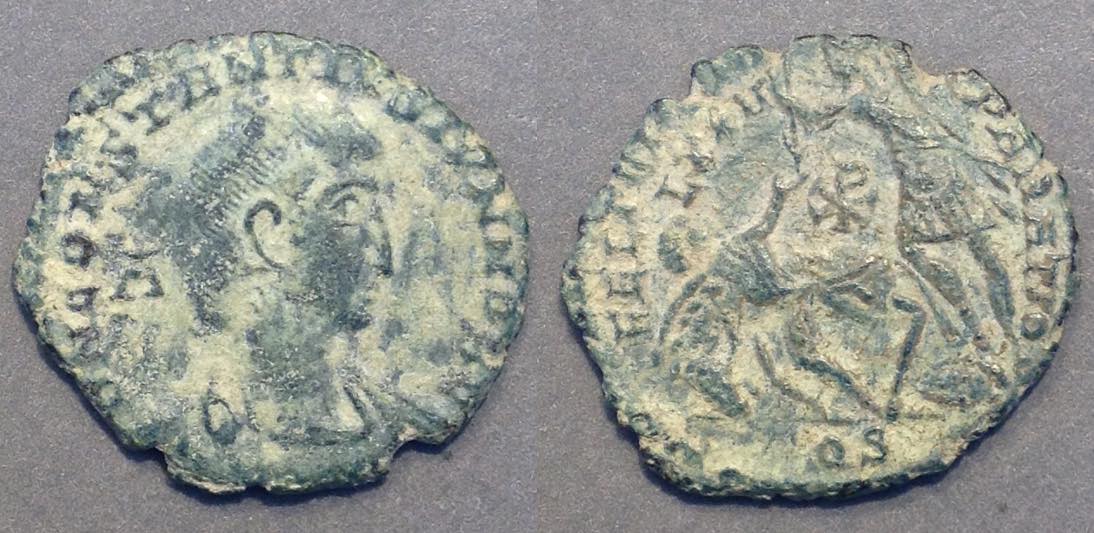 Constantius Gallus
Constantius GallusRIC Siscia 335 has LXXII as does Aquileia 189, 192, 194, 196.
 Constantius Gallus
Constantius Gallus
 Constantius Gallus
Constantius Gallus
24-23 mm. 6.14 grams.
FEL TEMP REPARATIO
soldier spearing fallen horseman
Γ
ALEA
RIC Alexandria 74
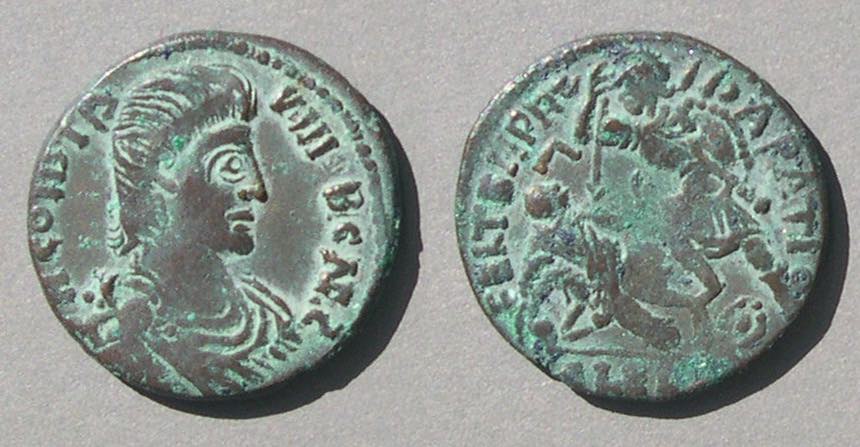 Ancient imitation of a Constantius Gallus
Ancient imitation of a Constantius Gallus
21 mm. 4.07 grams.
Mint and issue as above.
The legend is close to normal, but the letters are crudely formed. The terminal "S" on the obverse is reversed.
ALEA. Prototype RIC Alexandria 74, as above.
Types of Vetranio. Three types that were initially minted by Vetranio in the Balkans were retained after his retirement long enough to be used by Gallus at the Balkan mints Siscia, Sirmium, and Thesslonica.
 Constantius Gallus
Constantius Gallus
22 mm. 4.16 grams.
DN CONSTANTIVS IVN NOB C
Bare-headed
CONCORDIA MILITVM
Emperor holding two standands with chi-rhos, head left
III
ASIS•
RIC Siscia 308
 Constantius Gallus
Constantius Gallus
24-23 mm. 5.25 grams.
DN CONSTANTIVS IVN NOB C
CONCORDIA MILITVM
Emperor holding two standands with chi-rhos, head left
III
✳SIRM
RIC Sirmium 24

[Repeated from above.]
Constantius Gallus
22 mm. 4.16 grams.
FL IVL CONSTANTIVS IVN NOB C
CONCORDIA MILITVM
Emperor holding two standards with chi-rhos, head left
Γ
✳TSЄ✳
RIC Thessalonica 167 "S"
HOC SIGNO VICTOR ERIS. This type of Vetranio, issued only at Siscia and Sirmium, was the first Roman coin type to use an explicitly Christian legend, "In this sign you will be victorious," referring to the chi-rho on the standard. It was issued at Siscia in the names of Vetranio and Constantius II while Vetranio was ruling, and later for Constantius II and Gallus. When Vetranio abdicated, Sirmium was not yet open, so Sirmium did not issue for Vetranio. Sirmium issued the type for Constantius II and Gallus after September 351 when it opened.
 [Repeated from the table]
[Repeated from the table]
Constantius Gallus
23 mm. 6.75 grams.
DN CONSTANTIVS IVN NOB C
"A" behind bare headed bust right
HOC SIGNO VICTOR ERIS
emperor holding labarum with chi-rho,
being crowned by Victory
III
ASIS
RIC Siscia 306
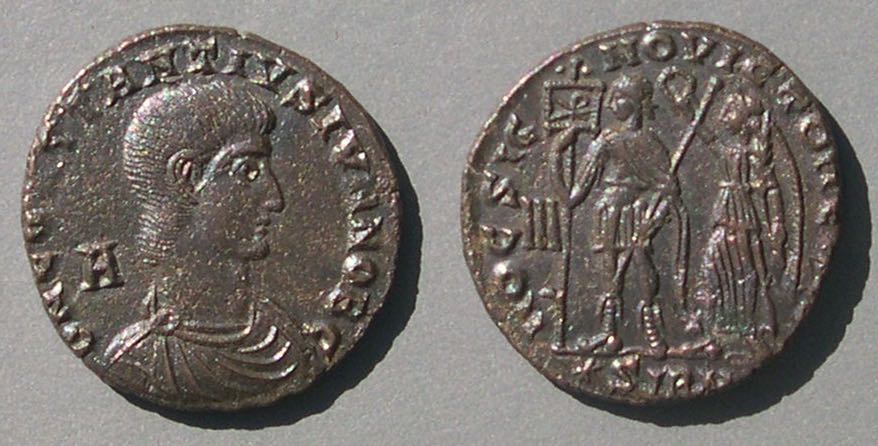 Constantius Gallus
Constantius Gallus(Same type as above, but from Sirmium)III
✳SIRM
RIC Sirmium 22
VICTORIA CAESARIS. One rare type for Gallus is listed in RIC as only from Siscia but the next coin shows it was minted at Sirmium too.
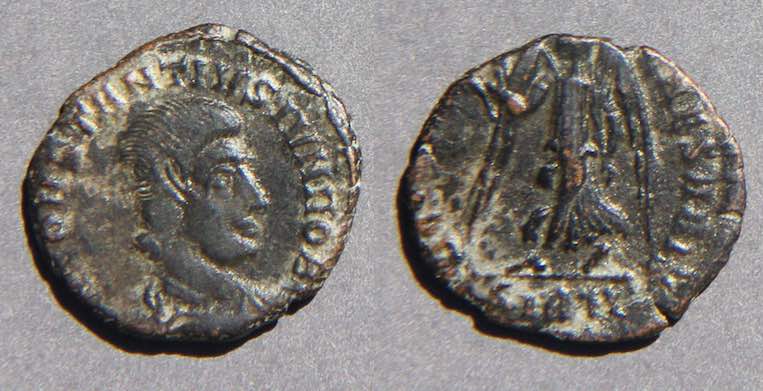 Constantius Gallus
Constantius Gallus
18-16 mm. 2.53 grams.
VICTORIA CAESARIS, Victory advancing left with wreath and palm
SIRM in exergue
Not in RIC for Sirmium. Same type as RIC Siscia 317.
This is in the same issue as RIC Sirmium 25 where the reverse is listed only for Constantius II.
Frequency: On June 19, 2019 a search of US eBay for "Constantius Gallus" yielded 192 results. Two were Constantius II misidentified. The rest are in the table. Be aware that it is hard to tell sizes from photos alone and some are much smaller than the large 23 mm coins. The same day on vcoins there were 79 of Gallus and three other coins misidentifed as Gallus. MA-Shops had 60 (many of which were also on vcoins) with two more misidentified as Gallus. June 23, 2019, a search of acsearch on "Constantius Gallus" brought up over 700 items, most of which were not AE coins of Gallus. The numbers of coins of the types on this web page are given in the table. CNG has archives that could be searched, but acsearch includes CNG coins. A French site,
http://www.nummus-bible-database.com
had 869 results for Constance Galle (their French spelling) on June 30, 2019, including 5 imitations (4 CM and 1 soldier-spearing). The others not in the total of 789 in the table were gold or silver coins or two AE medallions.
| Type | eBay | vcoins | MA-Shops | acsearch | Nummus-Bible |
| FTR Soldier-Spearing | 187 | 74 | 57 | 187 | 712 |
| SS with LXXII | 1 | 6 | 20 | ||
| SS with LXXII and chi-rho | 1 | 6 | |||
| HOC SIGNO VICTOR ERIS | 1 | 1 | 1 | 7 | 5 |
| CONCORDIA MILITVM | 1 | 3 | 1 | 21 | 28 |
| galley | 1 | 14 | 12 | ||
| VICTORIA CAESARIS | 1 | 3 | 0 | ||
| VICTORIA AVGVSTORVM | 1 | 3 | 2 | ||
| GLORIA ROMANORVM | 2 | 1 | |||
| VOT V MVLT X | 1 | 1 | |||
| phoenix | 2 | ||||
| total | 190 | 79 | 60 | 242 | 789 |
Every column is biased. Acsearch has auction coins and coins at auction are often selected to be better coins for condition or type. That column overemphasizes the rare types. However, at least those coins sold. The coins we see on current eBay and fixed-price sites are coins that have not sold. The vast majority are overpriced and will not sell at those prices. They get relisted on eBay or just sit there on vcoins or MA-Shops for a very long time and remain there for you and me to count whenever we look. It is likely that the unseen types are actually more available than the eBay and fixed-price numbers above suggest, but are sold more rapidly and are less likely to remain there on any particular day we look. Remember that the majority of collectors don't want more than one Gallus and one nice soldier-spearing-fallen-horseman will suffice. That implies two things. One, the demand for other scarcer types with consequent premiums is low and, two, there are many lousy soldier-spearing-fallen-horseman that will remain unsold (forever, at those prices).
Conclusion. By far the most common AE type for Constantius Gallus is soldier-spearing-fallen-horseman. It comes in sizes from 23-24 mm down to c. 16 mm.
References: The essential reference work is Roman Imperial Coinage, volume VIII, by J. P. C. Kent.
Failmezger, Victor "Tory". Roman Bronze Coins from Paganism to Christianity, 294 - 364 A.D.
Go to the Table of Contents for these educational pages.